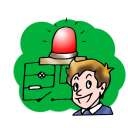By Trista L. Pollard

|
Ohm in the Circuit
By Trista L. Pollard |

|
 1 Although Benjamin Franklin had his moment in the "spot light", there were many scientists in the 18th and 19th centuries who worked to discover the mystery of electricity. Franklin's creation of the lightning rod in 1752 sparked the interest of scientists throughout Europe and America. During the late 1700s and 1800s these scientists tried to figure out how to produce electrical energy and how to store large amounts of electricity. This whole "electricity era" started with hanging frog legs, but it ended with an important law for measuring the flow of electricity.
1 Although Benjamin Franklin had his moment in the "spot light", there were many scientists in the 18th and 19th centuries who worked to discover the mystery of electricity. Franklin's creation of the lightning rod in 1752 sparked the interest of scientists throughout Europe and America. During the late 1700s and 1800s these scientists tried to figure out how to produce electrical energy and how to store large amounts of electricity. This whole "electricity era" started with hanging frog legs, but it ended with an important law for measuring the flow of electricity. |
Create Weekly Reading Books
Prepare for an entire week at once! |
| Leave your feedback on Ohm in the Circuit (grades 3-4) (use this link if you found an error in the story) |
 |
Electricity Worksheets | edHelper.com
|
 |
Science
|